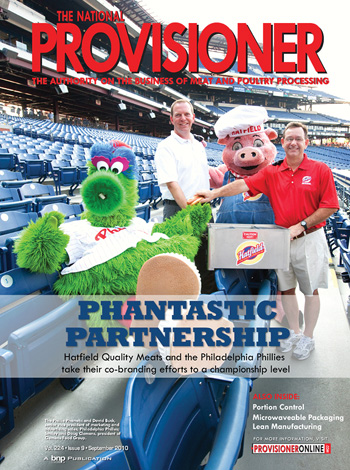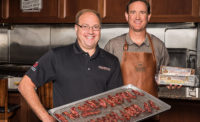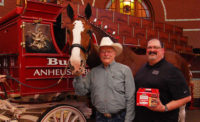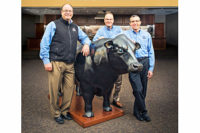
Peanuts and Cracker Jack? For today’s sports fans, the game-day experience has come a long way from the days described in the venerable song “Take Me Out to the Ballgame.” Today’s sports venues represent a bombardment of options in food, entertainment, souvenirs and experiences, all bolstered by a bevy of sponsorships and branding messages.
It’s no doubt the business world has hitched itself to this embellished experience—spending billions of dollars annually to get brands and messages attached to the ol’ ballgame. Yet, not all sports sponsorships are treated equally.
Hatfield Quality Meats, owned by Hatfield, Pa.-based Clemens Family Corp., embraces its longstanding partnership with Major League Baseball’s Philadelphia Phillies—a joint branding venture that has been in existence since Clemens purchased Medford Inc. nearly two decades ago. Hatfield inherited the popular Phillies Franks retail product in that acquisition and built a branding powerhouse on that foundation—an experience that goes beyond simply naming Hatfield as the supplier of the hot dogs.
Eric Haman, corporate communications manager for Hatfield Quality Meats, explains that many things make the partnership unique, but all are tied to the similarities between the two businesses.
“The Phillies, being a world-class organization, have a very rich history in Philadelphia, and Hatfield Quality Meats has a very rich history in our region as well,” he says. “It’s a good fit between the two organizations because of our heritage. Another thing that is extremely valuable and makes this partnership work is, … we understand what each other’s needs are. The Phillies are a business, and they need to get out of it what they need, and we’re a business that needs to get value out of the partnership too.”
Doug Clemens, president of Clemens Food Group and fourth-generation family member in the business, says the partnership works because of the identical values each organization possesses.
“Our company is built on values, and I know this organization is built on values too,” Clemens explains. “So people do what they say they’re going to do; when they talk about doing the right thing, they do it; and building for the long term, they do it. In our company, our core values are integrity, ethics and stewardship.”
Team chemistry
Rob MacPherson, director of corporate partnerships for the Phillies, knows his organization understands the special nature of the relationship.
“I don’t think a lot of teams can say that they have this kind of partner in the hot dog world—an organization that’s been around as long as Hatfield has, with its history and commitment to the community and such,” MacPherson says. In fact, when the Phillies built their new stadium, Citizens Bank Park (which opened in 2004), the organization wanted to create a fan experience that paid tribute to the history and tradition of Philadelphia. MacPherson says Hatfield fit that profile, and the partnership began to really flourish.
“Working with Hatfield was perfect,” he adds. “We’re going to sell hot dogs, but being able to partner on hot dogs with a company that’s been around here as long as we have, whose values are very similar to ours, whose product is excellent and who would help us when it came to theming the ballpark was a perfect storm of many things coming together.”
During the planning for the new stadium, Hatfield was given the opportunity to brand a few of the concession stands and kiosks that dot the stadium concourse, and the company jumped at the chance. Hatfield Grill features not only the Hatfield branding, but also the story of John C. Clemens, Doug’s great-grandfather and founder of the company. Other smaller kiosks are branded with the Hatfield name as well. Meanwhile, Hatfield also supplies the ballpark’s concession stands with a variety of sausage and other meat products—an opportunity that would not necessarily be available without the partnership with the Phillies.
A solid veteran core
The original piece of the partnership was Phillies Franks—retail packs of the very same hot dogs sold at the ballpark, co-branded with the Hatfield and Phillies logos. It was an already-established first step toward mutually beneficial, value-added branding efforts, Haman says.
“For a retailer to be able to offer these Phillies Franks—the same great hot dog you can get at the ballpark—to consumers to have in their homes, it’s huge,” he says. “So we tie in a lot of promotion around the sale of Phillies Franks, because it helps both of us.”
Yet Phillies Franks represented merely a starting point for the innovative approach the team and Hatfield would take toward building a memorable experience for their shared customers.
“Innovation has been huge in our partnership, and the Phillies have always been open to hearing our ideas for this or that—thinking outside of the normal things that come along as part of the partnership,” Haman says. “The Hot Dog Launcher is really the first innovative thing we came up with collectively.”
In the late 1990s, MacPherson says, the Phillies and Hatfield were looking for ways to step up the partnership through a fun, fan-interactive experience. At the time, he says, a typical ballpark staple was the launching of rolled-up t-shirts via slingshots to the crowd in the stands.
“There was a meeting at Hatfield to kick around a bunch of ideas, and someone said, ‘Wait a minute, I’ve got it! Can you [Phillies] guys be back here in two weeks?’” MacPherson explains. “And our guys said, ‘Sure,’ but they didn’t really know why they were coming back. They went back, and that’s when [Hatfield] had the device.”
The launcher has been so popular among fans that Hatfield even created a tongue-in-cheek documentary—with the help of the Phillie Phanatic and the Phillies organization—and posted it on YouTube. In just under two years, the six-minute flick had more than 111,600 views.
Adding the right mix of talent
The launcher represented “step one” of taking the partnership to the next level and it was a step that worked well in conjunction with the Phillies’ creation of the Dollar Dog Days promotion. MacPherson explains that Dollar Dog Days were originally developed to give fans an inexpensive, yet quality food option at the ballpark in the face of rising concessions costs. It also allowed the Phillies to drive attendance on certain dates.
“Moving into Citizens Bank Park, we’ve always had a pretty good attendance push,” he says. “So what we do with Dollar Dog Days is target a handful of dates every year that we know we’re going to have some challenges.”
On Aug. 19, 2010, the Phillies celebrated the 100th-consecutive sellout at Citizens Bank Park, a streak that MacPherson had previously admitted might not have been possible without promotions such as Dollar Dog Days. For its part, Hatfield takes advantage of the promotion and the large crowds that show up for the dollar dogs.
“It provides Hatfield an opportunity to be outside the gates sampling product that’s not for sale in the park—so they can extend their relationship with the consumers that way,” MacPherson says.
Hatfield started sampling product at the stadium two years ago, in the hopes of turning Dollar Dog Days into a total branding experience for fans. Hatfield gives fans a coupon to spur them to go to the store and purchase the product. Then, inside the park, fans are hit with the Hatfield brand when buying their dollar hot dogs and they see Smiley (Hatfield’s own mascot) and the Phanatic launching hot dogs into the crowd in between innings.
While Hatfield doesn’t currently print special coupons for the Phillies games, comments and calls on the company’s Web site and hotline encourage the company that its efforts are paying off.
“I don’t think the intention is to get measurable results here,” Clemens says. “It gives us an opportunity to interact with our customers, which is one of the primary reasons we do it. It’s a different venue and format, and it gives us a chance to let them sample some things and interact with us in a different way.”
Closer material
Of course, Hatfield could stick to simply branding the hot dogs—going the route of other “typical” sponsorship deals. Hatfield knows its customers appreciate the focus on values the company has, and based on that, Hatfield also donates 100 pounds of product to the local Philadelphia food bank, Philabundance, for every home run that the Phillies hit this season—again, similar to moves made by sponsors of other teams. So, why go the extra mile when many other companies with sports sponsorships do not?
All these innovations represent a monumental effort and expenditure of time and thought. However, the buzz created by the promotions has helped give Hatfield a steady stream of potential customers at the Phillies games.
MacPherson has first-hand knowledge that the Hatfield-based promotions are hitting home with some consumers, having been a “fly on the wall” while getting his car repaired a few years ago. He says one day a couple years before the Phillies won the World Series (in 2008), he overheard the mechanics — who did not know he worked for the team—talking about the Phillies on the shop floor.
“So, one guy says to the others, ‘I don’t know how well [the Phillies have] done, but I know one thing: I’m going to all the Dollar Dog Days!’” MacPherson says.
Clearly, Hatfield and the Phillies have struck a chord with fans—having truly created the co-branded fan experience they craved from the start. Hatfield’s efforts to build and fortify its partnership with the Phillies have kept it in prime shape to stay atop its game.
As for the next innovation in the partnership—fans will have to wait and see what Smiley and the Phanatic have up their mustard-stained sleeves.




Report Abusive Comment